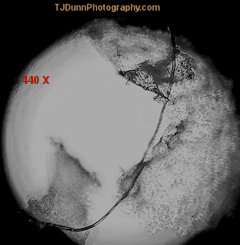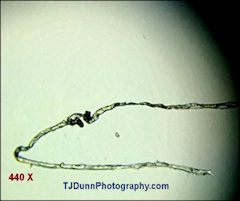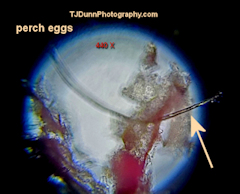

Collapse of a fish
population after exposure to a synthetic estrogen
The
author's study
of fish gender ratios being
dependent upon hormone and hormone mimmicking chemicals. Ambient water temperature plays a role,
as well.
_________________________________________________________
Metabolomic
profiling reveals the
intestinal toxicity of
different length of microplastic fibers on zebrafish (Danio rerio)
Zebrafish larvae and adults were exposed to different
length of microplastic fibers (50 ± 26 μm and 200 ± 90 μm). After
exposure,
microplastic fibers were observed in the gut of zebrafish even at the
early
life stage, causing length-dependent intestinal damage and toxicities
manifested by histopathological changes and biomarker responses. Long
microplastic fibers induced more serious effects. They significantly
decreased
the food intake of zebrafish by 54 %–67 % compared with short
microplastic
fibers.
| T. J. Dunn, DVM, the creator of this website,
has images of microscopic views of microplastic fibers embedded in various fresh water fish species, insects, and various grocery-bought food items. |
|||
 |
 |
 |
 |
| SOURCE: Fish (Bluegill) muscle |
SOURCE: Florida rain water |
SOURCE: Perch fish eggs |
SOURCE: Fast food fish sandwi |
Effects
of microplastics on head
kidney gene expression and enzymatic biomarkers in adult zebrafish
(NOTE: Xenobiotic is
a term used to
describe chemical substances that are foreign to animal life and thus
includes such examples as
plant constituents, drugs, pesticides, cosmetics, flavorings,
fragrances, food
additives, caffeine, industrial chemicals and environmental pollutants.)
Due
to massive production, improper
use, and disposal of plastics, microplastics have become global
environmental
pollutants affecting both freshwater and marine ecosystems. Several
studies
have documented the uptake of microplastics in wild species and the
correlated
biological effects, such as epithelial damage, inflammation, metabolic
alterations,
and neurotoxicity.
__________________________________________________________
Walleye
growth declines following zebra mussel
and Bythotrephes invasion
Both walleye and
yellow perch rely on zooplankton prey for a portion of their first year
of life
before switching to benthic macroinvertebrates and then fish (Wu and
Culver 1992;
Mittelbach and Persson 1998;
Galarowicz et al. 2006).
If native zooplankton become limited due
to the presence of either AIS, walleye and yellow perch may switch to
alternative food sources if they are large enough to make that shift
(Wu and
Culver 1992;
Gopalan et al. 1998)
or continue to persist on pelagic resources
(Bremigan et al. 2003;
Truemper et al. 2006).
In either case, their growth may be
affected. Growth of these fishes during the first year is critical to
survival
to later life stages, because larger individuals are less likely to
succumb to
size-selective predation (Nielsen 1980;
Roswell 2011)
and have access to a more diverse prey base
(Wu and Culver 1992).
SYNOPSIS OF BIOLOGICAL DATA ON THE WALLEYE Stizostedion v. vitreum (Mitchill 1818)1/ Prepared by Peter J. Colby, Richard E. McNicol and Richard A. Ryder Fisheries Research Station Ministry of Natural Resources http://www.fao.org/3/ap924e/ap924e.pdf
Laarman
(RESEARCHER…tjd)
stated that success or failure of walleye stocking appeared to depend
more on
the environmental and biological
conditions of individual bodies of
water than
on the number and size of walleye
that were stocked. (This
statement conflicts with local DNR activities stocking extended Growth
walleyes. Let us see what the science tells us. TJD)
Page 42: Cannibalism among walleyes has been observed in a number of lakes (Eschmeyer, 1950; Dobie, 1956; Rawson, 1957; Smith and Pycha, 1960; Fedoruk, 1966; Forney, 1968; Johnson, 1969). Titcomb (1921) observed cannibalism among hatchery reared fry as small as 13 mm long. Chevalier (1973) and Forney (1976) found cannibalism by adults on the YO? in Oneida Lake, New York to be a decisive factor in the formation of eight year classes which were followed from egg through age I. The duration of such cannibalism was influenced by the growth rate of young walleyes. Forney (1974) found that in Oneida Lake, cannibalism involving YOY walleyes decreased in years when YOY yellow perch were abundant but increased in years when YOY yellow perch were scarce. Incidence of cannibalism was seen to increase in the autumn as available perch abundance decreased. Thus, YOY yellow perch tended to act as a buffer in controlling cannibalism, and indirectly regulating walleye population size. Walleye predation regulated year class strength of yellow perch (Forney, 1971) and it is the primary source of perch mortality in communities dominated by both species (Swenson, pers. comm.). Adult walleyes have also been observed to feed occasionally on juvenile walleyes (Ryder, 1977). Winter foods consist mainly of fish (Doan, 1942; Galligan, 1960; Priegel, 1962e, 1962b) but when the availability of forage fish is limited, invertebrates beco
Walleyes
5-9 mm long, in rearing ponds,
fed largely on rotifers, Keratena cochlearis, Brachionus spp.,
Asplanchna Sp.,
Euchianis sp, and Synchaeta sp.; copepod nauplii and adults and Cyclops
and
Diaptomus; and small cladocerans, Chydorus and Bosmina (Smith and
Moyle,
1945). (This
surely reflects the kinds and numbers of matrix microorganisms, aka
zooplankton and phytoplankton, which should be present in the aquifer
if these newly hatched walleye are to thrive. This is great
evidence that an inventory of planktonic species and numbers should be
done PRIOR to stocking. TJD)
As the fry grew, copepods (now including Epischura) and cladocerans, including larger genera such as Daphnia and Leptodora, became the predominant food. Insects (predominantly mayfly nymphs) and fish soon become more important as the fry grow larger, until eventually fish become the predominant food (Kidd, 1927; Smith and Moyle, 1945; Smith and Pycha, 1960; Forney and Houde, 1965; Dobie, 1966a). Bulkley, Spykermann and Inmon, (1976) observed walleye fry in Clear Lake, Iowa, to feed initially upon larger zooplankters, espeaially the cladoceran Daphnia, even though rotifers and copepod nauplii were fairly abundant. Dobie (1966a) reported that when young walleyes had reached a length of 30 mm, they shifted to feeding on fish. YOY (Young Of the Year TJD) yellow perch are the forage fish most often consumed by walleye fry (Eschmeyer, 1950; Maloney and Johnson, 1957; Dobie, 1966a; Johnson, Thomasson and Caldwell, 1966; Wolfert, 1966), although when abundant, other species have been important, especially fresh water drum and trout-perch (Priegel, 1960; 1963; 1969b), johnny darters (Raney and Lachner, 1942), spottail shiners (Smith and Pycha, 1960), and black crappies (Johnson, Thomasson and Caldwell, 1966). In Little Cutfoot Sioux Lake, Minnesota, where yellow perch are relatively unavailable because of their rapid growth rate, YOY walleyes continue feeding on invertebrates, mainly aquatic insects (Johnson, 1969).
__________________________________________________________
1995 Behavior of larval walleye: Phillip Warren Rieg
Cannibalism and mortality seem to occur at a greater rate at higher temperature, but for a shorter time. Further studies to develop an optimum temperature management strategy that accelerates passage of larvae through the critical periods and improves GBI and first feeding success without significantly increasing cannibalism or other mortalities may prove valuable in further development of intensive walleye larviculture.
In conclusion, we found evidence that rearing temperatures of 20°C would increase performance and viability of walleye larvae in intensive culture. Higher temperatures seem to accelerate passage through the critical period because of a greater initial activity level which improves first feeding success. Cannibalism and mortality seem to occur at a greater rate at higher temperature, but for a shorter time. Further studies to develop an optimum temperature management strategy that accelerates passage of larvae through the critical periods and improves GBI and first feeding success without significantly increasing cannibalism or other mortalities may prove valuable in further development of intensive walleye larviculture.
WALLEYE
EGG PREDATION
IDENTIFYING
RECRUITMENT BOTTLENECKS FOR
AGE-0 WALLEYE IN NORTHERN WISCONSIN LAKES
By Hadley I. A. Boehm
Previous research has identified some
species of panfish as walleye egg
predators (Roseman et al. 2006), so further
panfish predation studies could be conducted during the walleye egg
phase. However, a previous study of competition
between walleye and smallmouth bass in their sympatric native range
showed that
smallmouth bass did not prey on juvenile walleye and the diet overlap
between
the two was not significant. On top of this, one walleye even had a
smallmouth
bass in its stomach (Frey et al. 2003)
|
More topics on the microplastic hazard to
fresh
water organisms
Ecotoxicological aspects related to the presence of
pharmaceuticals in the aquatic environment - Cristina
Delerue-MatosPharmaceuticals and personal care products (PPCPs) in the freshwater aquatic environment - Sbusiso Prince Emerging Chemicals and Analytical Methods - Mostafa Fatemi Aquatic Toxicology Chapter: Eco-toxicological Impact of Pharmaceuticals for Human Use in Aquatic Systems - Franco Dani Managing emerging contaminants in watersheds: Need for comprehensive, systems-based strategies - ammara talib Pharmaceutical and personal care products in domestic wastewater and their removal in anaerobic treatment systems: septic tank – up flow anaerobic filter - Ingeniería e Investigación, Jhon Gonzalez, Carlos A Ramirez-Vargas Fate of diclofenac in municipal wastewater treatment plant — A review - Mika Sillanpää Human Pharmaceuticals in the Aquatic Environment: A Challenge to Green Chemistry - Sushil Kheta |
___________________________________________________
of this beautiful space matter we call Earth as it spins on its axis at 1000 mph. Together we orbit around our small
star at 67,000 mph. Amazingly our star and Earth are mutually attracted to each other by the
invisible force of gravity as we all fly through space at 490,000 mph around the
center of a single galaxy among billions upon billions of other
galaxies. And everyone in our earthbound family
dances together among the stars
on an unimaginable journey
from somewhere to somewhere else!
_______________
Love one another as we wish to be loved.
(Visit EarthIsSick.com)